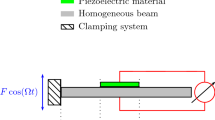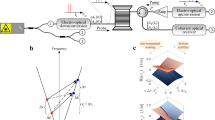Analyse
A fin d’appliquer une formule générale du coefficient de couplage basée sur la réciprocité, on étudie la réflexion d’un mode d’une fibre optique sur l’extrémité de celleci. La généralisation d’une théorie bidimensionnelle de Lewin permet d’obtenir des expressions exactes à Δ2/∇4 près, oú Δest l’écart relatif des indices entre cœur et gaine et oú ∇est la fréquence normalisée classique dans la théorie des fibres. L’application de cette théorie au problème de l’excitation d’un mode permet de vérifier que les théories plus anciennes ne sont exactes qu’à des termes en Δ/∇2 près.
Abstract
The fields reflected and radiated at the end of an optical fiber which is illuminated by a guided mode are studied through the extension of a two dimensional theory previously given by Lewin. The accuracy of the new theory is estimated to be roughly Δ2/∇4 (Δ =relative difference between core index and cladding index; ∇ =normalized frequency). These fields are introduced in a rigorous formula for the coupling efficiency based upon reciprocity, resulting in expressions more accurate than those previously known which have a Δ/∇2 accuracy only.
Similar content being viewed by others
Bibliographie
Marcuse (D.). Excitation of the dominant mode of a round fiber by a gaussian beam (Excitation du mode fondamental d’une fibre circulaire par un faisceau gaussien).Bell Syst. tech. J., U.S.A. (1970),49, n∘ 8, pp. 1 595–1 703.
Snyder (A. W.),Pask (D.),Mitchell (D. J.). Light acceptance property of an optical fiber (Capacité d’admission de la lumière par une fibre optique).J. opt. soc. Amer. (1973),63, n∘ 1, pp. 59–64.
Snyder (A. W.). Excitation and scatterring of modes on a dielectric or optical fiber (Excitation et diffusion des modes d’un guide diélectrique ou d’une fibre optique).I.E.E.E. Trans. M.T.T., U.S.A. (1969),17, n∘ 12, pp. 1 138–1 144.
Mostafavi (M.),Itoh (T.),Mittra (R.). Excitation of an optical fiber by a gaussian beam (Excitation d’une fibre optique par un faisceau gaussien)Appl. Optics. U.S.A. (1975),14, n∘ 9, pp. 2 190–2 193.
Vassallo (C.). Matrices de répartition pour des systèmes ouverts. Application aux problèmes de couplage en optique guidée.Ann. Télécommunic. Fr. (1976),31, n∘ 9–10, pp. 291–298.
Vassallo (C.). On a rigorous calculation of the efficiency for coupling light into optical waveguides (Sur un calcul rigoureux du coefficient de couplage de la lumière dans les guides optiques).I.E.E.E. J. QE, U.S.A. (1977),13, n∘ 4, part 2, pp. 165–172.
Di Vita (P.),Vanucci (R.). Geometrical theory of coupling errors in dielectrics optical waveguides (Théorie géométrique des imperfections de couplage entre guides optiques).Opt. Communic., G. B. (1975),14, n∘ 1, pp. 139–144.
Lewin (L.). A method for the calculation of the radiation pattern and mode conversion properties of a solid state heterojunction laser (Une méthode pour calculer le diagramme de rayonnement d’un laser à état solide et à hétérojunction et ses propriétés de conversion modales).I.E.E.E. Trans. M.T.T., U.S.A. (1975),23, n∘ 7, pp. 576–585.
Snyder (A. W.). Surface waveguide modes along a semi infinite dielectric fiber excited by a plane wave (Modes guidés de surface sur une fibre diélectrique semi infinie excitée par une onde plane),J. opt. soc. Amer. (1966),56, n∘ 5, pp. 601–606.
Kapany (N. S.),Burke (J. J.),Sawatari (T.). A technique for launching an arbitrary mode on an optical dielectric waveguide (Une technique pour exciter un mode arbitraire dans un guide optique).J. opt. soc. Amer. (1970),60, n∘ 9, pp. 1 178–1 185.
Biernson (G.),Kingsley (D. J.). Generalized plots of mode patterns in a cylindrical dielectric waveguide applied to the retinal cones (Diagrammes généralisés pour les modes d’un guide diélectrique cylindrique, application aux cônes rétiniens).I.E.E.E. Trans. M.T.T., U.S.A. (1965),13, n∘ 3, pp. 345–356.
Morse (P. M.),Fesshbach (H.). Methods of theoretical physics (Les méthodes de la physique théorique.)McGraw Hill, New-York (1953), p 766.
Author information
Authors and Affiliations
Rights and permissions
About this article
Cite this article
Vassallo, C. Un calcul plus précis de l’excitation d’un mode d’une fibre optique. Ann. Télécommunic. 32, 224–233 (1977). https://doi.org/10.1007/BF02998533
Received:
Issue Date:
DOI: https://doi.org/10.1007/BF02998533




